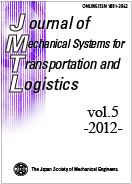Volume 5, Issue 1
Displaying 1-9 of 9 articles from this issue
- |<
- <
- 1
- >
- >|
Papers
-
2012Volume 5Issue 1 Pages 1-13
Published: 2012
Released on J-STAGE: February 02, 2012
Download PDF (907K) -
2012Volume 5Issue 1 Pages 14-29
Published: 2012
Released on J-STAGE: February 14, 2012
Download PDF (695K) -
2012Volume 5Issue 1 Pages 30-42
Published: 2012
Released on J-STAGE: March 06, 2012
Download PDF (657K) -
2012Volume 5Issue 1 Pages 43-57
Published: 2012
Released on J-STAGE: March 19, 2012
Download PDF (626K) -
2012Volume 5Issue 1 Pages 58-70
Published: 2012
Released on J-STAGE: April 17, 2012
Download PDF (1825K) -
2012Volume 5Issue 1 Pages 71-85
Published: 2012
Released on J-STAGE: June 05, 2012
Download PDF (736K) -
2012Volume 5Issue 1 Pages 86-97
Published: 2012
Released on J-STAGE: June 12, 2012
Download PDF (869K) -
2012Volume 5Issue 1 Pages 98-109
Published: 2012
Released on J-STAGE: July 11, 2012
Download PDF (1206K) -
2012Volume 5Issue 1 Pages 110-119
Published: 2012
Released on J-STAGE: November 07, 2012
Download PDF (740K)
- |<
- <
- 1
- >
- >|
